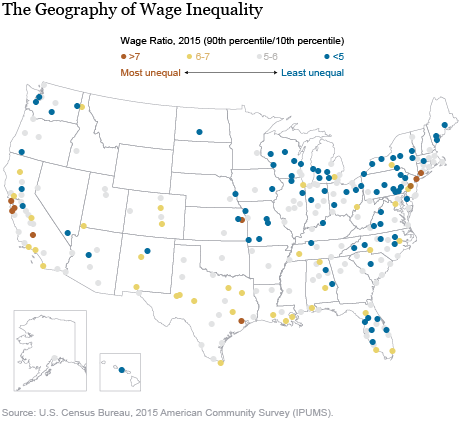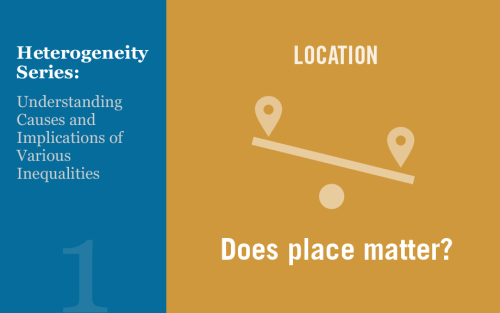Economic inequality in the United States is much more pronounced in some parts of the country than others. In this post, we examine the geography of wage inequality, drawing on our recent Economic Policy Review article. We find that the most unequal places tend to be large urban areas with strong economies where wage growth has been particularly strong for those at the top of the wage distribution. The least unequal places, on the other hand, tend to have relatively sluggish economies that deliver slower wage growth for high, middle, and lower wage earners alike. Many of the least unequal places are concentrated in the Rust Belt. These differences in the degree of wage inequality are tied to powerful economic forces arising from technological change and globalization, which have pushed up wages strongly for high-skilled workers in locations that have become the most unequal. Yet those same forces have kept wage growth compressed within a fairly narrow range for workers in places that are the least unequal.
Where Is Wage Inequality Greatest?
While there are many metrics for measuring wage inequality, they tend to be highly correlated and exhibit similar patterns. We focus on the ratio of the wages earned by a worker at the 90th percentile of the wage distribution to the wages earned by a worker at the 10th percentile, often referred to as the 90/10 ratio, which we show in the map below. The metropolitan areas in copper and yellow—with 90/10 ratios above 6—are the most unequal places in the country, while the metropolitan areas in blue—with 90/10 ratios below 5—are the least unequal places.
Many large urban areas, such as New York City, Washington, D.C., Chicago, Houston, Los Angeles, and the San Francisco Bay area, are among the most unequal places. Inequality is also relatively high in parts of the South, such as metro areas in Texas, Louisiana, and Alabama. By contrast, wage inequality is lowest in metropolitan areas in the Midwest and the Great Lakes region, often referred to as the “Rust Belt,” as well as in Washington State and some parts of Florida.

What Makes Some Places More Unequal than Others?
These regional differences in wage inequality reflect the local effects of technological change and globalization on workers. These effects conform to one of two general patterns. In one set of places, technological change and globalization have led to a vibrant economy and strong demand for skilled labor. For example, San Francisco has seen a burgeoning tech sector in recent decades, resulting in strong demand and vigorous wage growth for highly skilled workers, especially those at the very top of the wage distribution. Likewise, skilled workers in the finance industry have been in strong demand in New York City, and their wages are particularly high. In places like these, wages for skilled workers toward the top of the wage distribution have increased significantly relative to those at the middle and bottom, resulting in relatively high levels of wage inequality.
In other places, technological change and globalization have led to weak economic conditions and lackluster wage growth across the board as these powerful economic forces have displaced many middle- and lower-skilled workers. This dynamic has played out in Detroit, for example, where the auto industry has eliminated thousands of jobs—cuts brought about both by automation and by auto plant closures, some of which have been tied to increased global competition. In addition to stagnant wages in the middle and lower portions of the wage distribution, demand for the most skilled workers has been weak in many of these places. This dynamic has resulted in sluggish wage growth for high-wage earners, which, when combined with slower wage growth among middle and lower skilled workers, has resulted in more compressed wage distributions than those seen in economies with stronger growth.
Other Factors at Work
While technological change and globalization have been the key drivers of these geographic patterns, there are two other important factors contributing to and reinforcing regional differences in wage inequality. First, agglomeration economies—or the benefits that arise when people and firms locate in large numbers near one another in cities—have enhanced the productivity and wages of skilled workers in large, dense metropolitan areas. While agglomeration economies have been shown to raise the productivity of all workers, recent research has found that these benefits tend to favor higher-skilled workers more than lesser-skilled workers. As a result, highly skilled workers in places where skill is concentrated tend to command even higher wages than they would earn elsewhere, amplifying wage inequality in those places. Second, migration within the United States has changed the mix of workers across places. Indeed, since the early 1980s, skilled workers have become much more geographically concentrated as those with college and graduate degrees have flocked to large cities while lesser-skilled workers have increasingly been priced out of such places—in no small part because of high and rising housing costs. This pattern of internal migration has reinforced the productivity benefits of agglomeration economies in many places.
Workers Affected Differently
These economic forces have affected workers very differently in various parts of the country. As a result, some places are now much more unequal than others. Indeed, as our analysis of the geography of wage inequality shows, relatively high regional wage inequality is often a consequence of strong but uneven economic growth, while a relatively low level of regional wage inequality is often the result of a weakening local economy. Thus, to the extent that policymakers wish to address inequality at the local/regional level, these findings are an important first step toward understanding the magnitude and sources of regional wage inequality.
 Jaison R. Abel is an assistant vice president in the Federal Reserve Bank of New York’s Research and Statistics Group.
Jaison R. Abel is an assistant vice president in the Federal Reserve Bank of New York’s Research and Statistics Group.
 Richard Deitz is an assistant vice president in the Bank’s Research and Statistics Group.
Richard Deitz is an assistant vice president in the Bank’s Research and Statistics Group.
How to cite this post:
Jaison R. Abel and Richard Deitz, “Some Places Are Much More Unequal than Others,” Federal Reserve Bank of New York Liberty Street Economics, October 7, 2019, https://libertystreeteconomics.newyorkfed.org/2019/10/some-places-are-much-more-unequal-than-others.html.
Disclaimer
The views expressed in this post are those of the authors and do not necessarily reflect the position of the Federal Reserve Bank of New York or the Federal Reserve System. Any errors or omissions are the responsibility of the authors.











 RSS Feed
RSS Feed Follow Liberty Street Economics
Follow Liberty Street Economics
Jeffrey: Many thanks for your comments on this post. In terms of the spatial unit of this analysis, we focus on metropolitan areas as they are a good approximation of local labor markets. So, yes, when we refer to Fairfield, CT, in this post it is the Fairfield County metro area, not the town.
I am using this for my undergrad class. Nice work gentlemen!
I can only imagine you mean the Fairfield COUNTY metro area. Fairfield CT is a town of 60K people and hardly a metropolitan area, but you never use the word “county” in this publication.